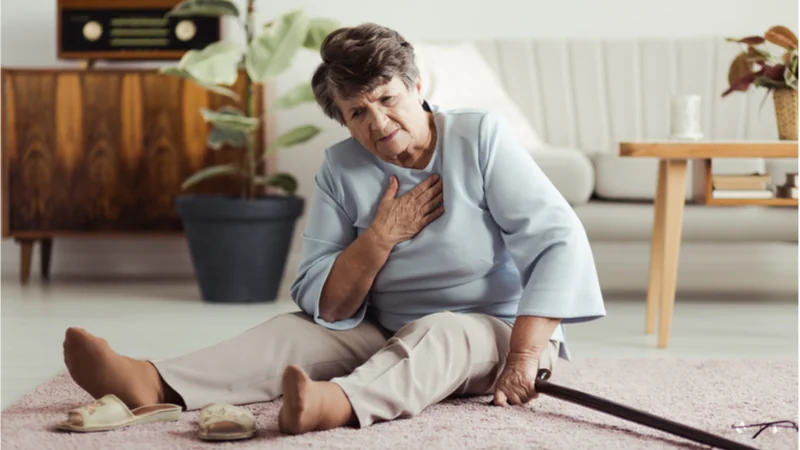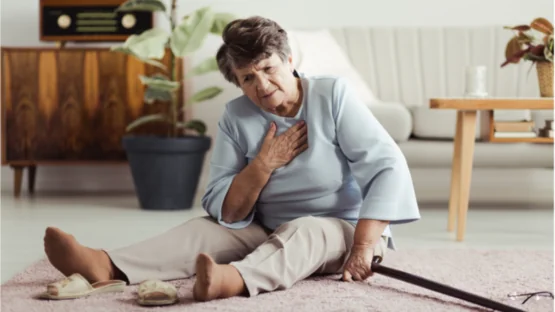In a new longitudinal study published in European Geriatric Medicine, the researchers have shown that people experiencing moderate to severe pain in multiple sites have an increased risk of falls, particularly in middle age [1].
Aging and falls
In one’s youth, falling doesn’t seem dangerous and might be enjoyable; people talk about falling into fluffy snow and falling in love. However, falls often lead to serious injuries and can even be fatal for older adults. Older, inactive females are particularly vulnerable to falls and subsequent injuries.
Prevention of falls involves finding and reversing their risk factors. For example, a recent study has shown that older women with carotid plaques have a higher risk of fall-related hospitalization [2]. Therefore, lifestyle changes, including exercise and a healthier diet, might reduce the risk of falls while improving cardiovascular health.
Pain is highly prevalent in adults over the age of 65 years old [3] and has been associated with a higher risk of falls. Whether or not pain is a cause of falls in this age group or merely a consequence of age-related co-morbidities that can lead to falls, such as arthritis, is unclear.
In this study, the researchers sought to explore the association between pain and falls in more detail in two age groups: middle-aged and older adults. They investigated if pain intensity and the number of pain sites were predictive of the risk of falling.
A multicountry survey
The Survey of Health, Ageing and Retirement in Europe (SHARE) recruited 40,636 people over 50 years old from 14 European countries. As the name suggests, the participants answered a series of questions about their height, weight, medications, co-morbidities, physical inactivity, vision, hearing, self-rated health, living companions, pain, and falls.
Participants reported the presence and intensity of pain and specified where it occurred. The participants were then asked if they experienced falls in the last 6 months. Two interviews were conducted two years apart.
First, the researchers show that ~40% of all the participants reported pain of varying degrees (mild, moderate, or severe). Women experience more pain of higher intensity and in multiple sites than men. Not surprisingly, severe pain was reported by older, inactive participants who were in poorer health and had co-morbidities that required medications. These participants were also more likely to have pain in multiple sites. Of all the pain sites, back pain was the most frequent complaint.
No pain, no falls
The initial survey revealed that 4.3% of men and 7.7% women experienced falls in the last 6 months. These numbers increased to 5.0% and 8.4%, respectively, two years later. Participants with pain were more likely to fall in the preceding and subsequent months, regardless of sex.
After adjusting for co-variates, such as co-mobidities and BMI, moderate and severe pain were associated with an increased risk of falls. Interestingly, there were age-specific differences: the presence of moderate and severe pain was predictive of falls in participants between 50 and 79 years of age but not in people over 80 years old.
Importantly, participants with pain in multiple sites had a higher risk of falling than those with one-site pain. ~50% of participants suffering from pain of various severity reported pain in multiple sites.
There were some country-specific differences in terms of pain prevailance and fall frequency. For example, participants from Switzerland were among the most likely to be pain- and fall-free. Meanwhile the participants from France were among the most likely to experience pain and fall regardless of sex.
Abstract
Aim: To explore the longitudinal associations between pain characteristics at baseline and subsequent falls risks, at 2-year follow-up, in community-dwelling adults aged ≥ 50 years, in the Survey of Health, Ageing and Retirement in Europe (SHARE).
Findings: Higher intensity of pain and number of pain sites at baseline were associated with an increased risk of subsequent falls in community-dwelling adults, in a dose–response way, independent of socio-demographic and clinical characteristics. The strength of the association between pain intensity and falls risk varied by age, being greater in middle-aged adults.
Message: The association between pain intensity and falls risk is of greater clinical significance in middle-aged adults versus older adults.
Conclusion
This study revealed that a higher intensity of pain and multiple pain sites are predictive of falls. Although this study doesn’t prove any causal link between pain and falls, the authors suggest several mechanisms that might underlie the association, including physical inactivity. If pain is caused by a sedentary lifestyle [4], it could lead to activity avoidance, which deconditions the muscles, reduces their strength, and impairs balance, making one more prone to falling. Therefore, minimizing the risk of falls is yet another reason to lead an active lifestyle.
Literature
[1] Ogliari, G., Ryg, J., Andersen-Ranberg, K., Scheel-Hincke, L. L., Collins, J. T., Cowley, A., … & Masud, T. (2022). Association of pain and risk of falls in community-dwelling adults: a prospective study in the Survey of Health, Ageing and Retirement in Europe (SHARE). European geriatric medicine, 1-14.
[2] Gebre, A. K., Sim, M., Dalla Via, J., Rodríguez, A. J., Hodgson, J. M., Bondonno, C. P., … & Lewis, J. R. (2022). Measures of carotid atherosclerosis and fall-related hospitalization risk: The Perth Longitudinal Study of Ageing Women. Nutrition, Metabolism and Cardiovascular Diseases.
[3] Domenichiello, A. F., & Ramsden, C. E. (2019). The silent epidemic of chronic pain in older adults. Progress in Neuro-Psychopharmacology and Biological Psychiatry, 93, 284-290.
[4] Hanna, F., Daas, R. N., El-Shareif, T. J., Al-Marridi, H. H., Al-Rojoub, Z. M., & Adegboye, O. A. (2019). The relationship between sedentary behavior, back pain, and psychosocial correlates among university employees. Frontiers in public health, 7, 80.




